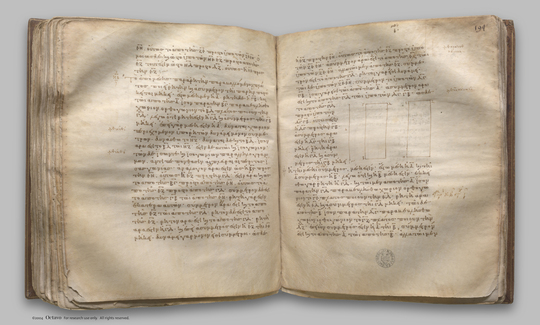index prev next | digilib folio 198

A straight line commensurable with a medial straight line is medial.
| Ἡ τῇ μέσῃ σύμμετρος μέση ἐστίν. Ἔστω μέση ἡ Α, καὶ τῇ Α σύμμετρος ἔστω ἡ Β: λέγω, ὅτι καὶ ἡ Β μέση ἐστίν. Ἐκκείσθω γὰρ ῥητὴ ἡ ΓΔ, καὶ τῷ μὲν ἀπὸ τῆς Α ἴσον παρὰ τὴν ΓΔ παραβεβλήσθω χωρίον ὀρθογώνιον τὸ ΓΕ πλάτος ποιοῦν τὴν ΕΔ: ῥητὴ ἄρα ἐστὶν ἡ ΕΔ καὶ ἀσύμμετρος τῇ ΓΔ μήκει. τῷ δὲ ἀπὸ τῆς Β ἴσον παρὰ τὴν ΓΔ παραβεβλήσθω χωρίον ὀρθογώνιον τὸ ΓΖ πλάτος ποιοῦν τὴν ΔΖ. ἐπεὶ οὖν σύμμετρός ἐστιν ἡ Α τῇ Β, σύμμετρόν ἐστι καὶ τὸ ἀπὸ τῆς Α τῷ ἀπὸ τῆς Β. ἀλλὰ τῷ μὲν ἀπὸ τῆς Α ἴσον ἐστὶ τὸ ΕΓ, τῷ δὲ ἀπὸ τῆς Β ἴσον ἐστὶ τὸ ΓΖ: σύμμετρον ἄρα ἐστὶ τὸ ΕΓ τῷ ΓΖ. καί ἐστιν ὡς τὸ ΕΓ πρὸς τὸ ΓΖ, οὕτως ἡ ΕΔ πρὸς τὴν ΔΖ: σύμμετρος ἄρα ἐστὶν ἡ ΕΔ τῇ ΔΖ μήκει. ῥητὴ δέ ἐστιν ἡ ΕΔ καὶ ἀσύμμετρος τῇ ΔΓ μήκει: ῥητὴ ἄρα ἐστὶ καὶ ἡ ΔΖ καὶ ἀσύμμετρος τῇ ΔΓ μήκει: αἱ ΓΔ, ΔΖ ἄρα ῥηταί εἰσι δυνάμει μόνον σύμμετροι. ἡ δὲ τὸ ὑπὸ ῥητῶν δυνάμει μόνον συμμέτρων δυναμένη μέση ἐστίν. ἡ ἄρα τὸ ὑπὸ τῶν ΓΔ, ΔΖ δυναμένη μέση ἐστίν: καὶ δύναται τὸ ὑπὸ τῶν ΓΔ, ΔΖ ἡ Β: μέση ἄρα ἐστὶν ἡ Β. Πόρισμα Ἐκ δὴ τούτου φανερόν, ὅτι τὸ τῷ μέσῳ χωρίῳ σύμμετρον μέσον ἐστίν. [ δύνανται γὰρ αὐτὰ εὐθεῖαι, αἵ εἰσι δυνάμει σύμμετροι, ὧν ἡ ἑτέρα μέση: ὥστε καὶ ἡ λοιπὴ μέση ἐστίν. ] Ὡσαύτως δὲ τοῖς ἐπὶ τῶν ῥητῶν εἰρημένοις καὶ ἐπὶ τῶν μέσων ἐξακολουθεῖ, τὴν τῇ μέσῃ μήκει σύμμετρον λέγεσθαι μέσην καὶ σύμμετρον αὐτῇ μὴ μόνον μήκει, ἀλλὰ καὶ δυνάμει, ἐπειδήπερ καθόλου αἱ μήκει σύμμετροι πάντως καὶ δυνάμει. ἐὰν δὲ τῇ μέσῃ σύμμετρός τις ᾖ δυνάμει, εἰ μὲν καὶ μήκει, λέγονται καὶ οὕτως μέσαι καὶ σύμμετροι μήκει καὶ δυνάμει, εἰ δὲ δυνάμει μόνον, λέγονται μέσαι δυνάμει μόνον σύμμετροι. | A straight line commensurable with a medial straight line is medial. Let A be medial, and let B be commensurable with A; I say that B is also medial. For let a rational straight line CD be set out, and to CD let the rectangular area CE equal to the square on A be applied, producing ED as breadth; therefore ED is rational and incommensurable in length with CD. [X. 22] And let the rectangular area CF equal to the square on B be applied to CD, producing DF as breadth. Since then A is commensurable with B, the square on A is also commensurable with the square on B. But EC is equal to the square on A, and CF is equal to the square on B; therefore EC is commensurable with CF. And, as EC is to CF, so is ED to DF; [VI. 1] therefore ED is commensurable in length with DF. [X. 11] But ED is rational and incommensurable in length with DC; therefore DF is also rational [X. Def. 3] and incommensurable in length with DC. [X. 13] Therefore CD, DF are rational and commensurable in square only. But the straight line the square on which is equal to the rectangle contained by rational straight lines commensurable in square only is medial; [X. 21] therefore the side of the square equal to the rectangle CD, DF is medial. And B is the side of the square equal to the rectangle CD, DF; therefore B is medial. PORISM. From this it is manifest that an area commensurable with a medial area is medial. [And in the same way as was explained in the case of rationals [Lemma following X. 18] it follows, as regards medials, that a straight line commensurable in length with a medial straight line is called medial and commensurable with it not only in length but in square also, since, in general, straight lines commensurable in length are always commensurable in square also. |